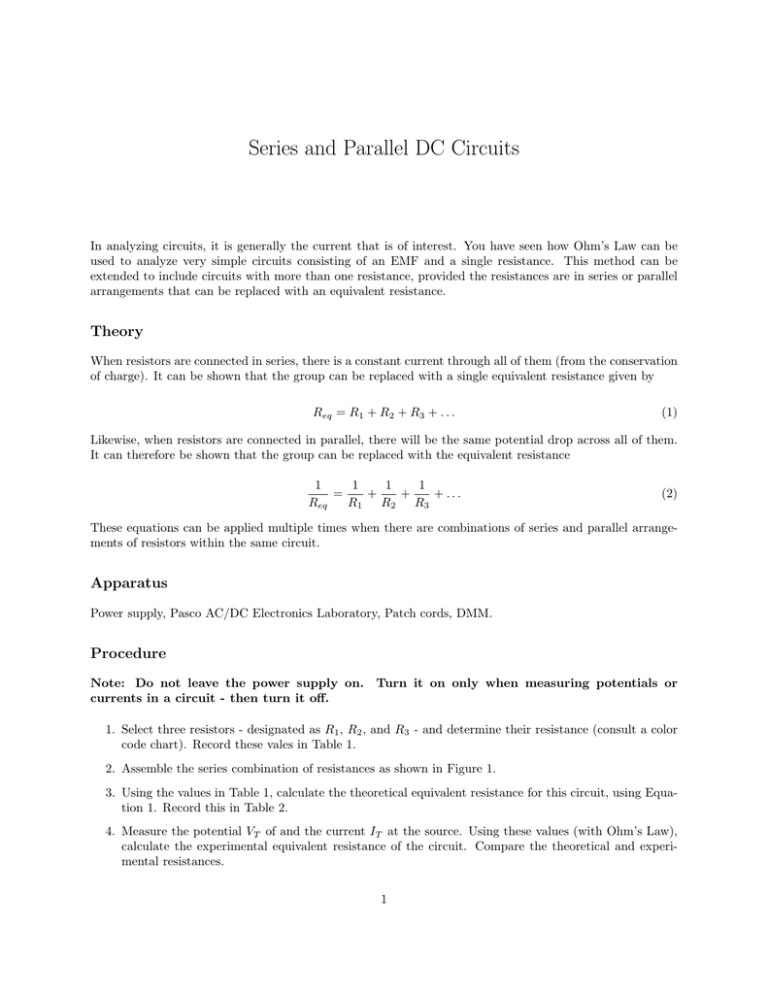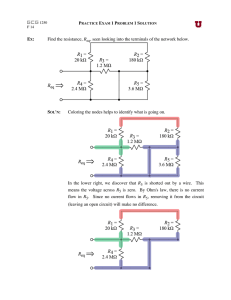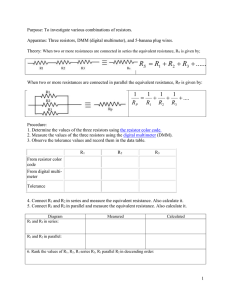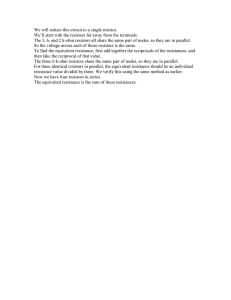Series and Parallel DC Circuits
advertisement

Series and Parallel DC Circuits In analyzing circuits, it is generally the current that is of interest. You have seen how Ohm’s Law can be used to analyze very simple circuits consisting of an EMF and a single resistance. This method can be extended to include circuits with more than one resistance, provided the resistances are in series or parallel arrangements that can be replaced with an equivalent resistance. Theory When resistors are connected in series, there is a constant current through all of them (from the conservation of charge). It can be shown that the group can be replaced with a single equivalent resistance given by Req = R1 + R2 + R3 + . . . (1) Likewise, when resistors are connected in parallel, there will be the same potential drop across all of them. It can therefore be shown that the group can be replaced with the equivalent resistance 1 1 1 1 = + + + ... Req R1 R2 R3 (2) These equations can be applied multiple times when there are combinations of series and parallel arrangements of resistors within the same circuit. Apparatus Power supply, Pasco AC/DC Electronics Laboratory, Patch cords, DMM. Procedure Note: Do not leave the power supply on. Turn it on only when measuring potentials or currents in a circuit - then turn it off. 1. Select three resistors - designated as R1 , R2 , and R3 - and determine their resistance (consult a color code chart). Record these vales in Table 1. 2. Assemble the series combination of resistances as shown in Figure 1. 3. Using the values in Table 1, calculate the theoretical equivalent resistance for this circuit, using Equation 1. Record this in Table 2. 4. Measure the potential VT of and the current IT at the source. Using these values (with Ohm’s Law), calculate the experimental equivalent resistance of the circuit. Compare the theoretical and experimental resistances. 1 5. Measure the potential drop across each individual resistor as well as the current through it. 6. Repeat the procedure with the parallel combination of resistances (Figure 2, Table 3). 7. Repeat the procedure with the series/parallel combination of resistances (Figure 3, Table 4). Table 1: Resistors R1 (Ω) R2 (Ω) R3 (Ω) 2 Figure 1: Series Resistances Table 2: Analysis of Series Circuit Theoretical equivalent resistance, Req (Ω) Potential at source, VT (V) Current at source, IT (A) Experimental equivalent resistance (Ω) Percent error in equivalent resistances Potential drop across R1 , V1 (V) Potential drop across R2 , V2 (V) Potential drop across R3 , V3 (V) Current through R1 , I1 (A) Current through R2 , I2 (A) Current through R3 , I3 (A) 3 Figure 2: Parallel Resistances Table 3: Analysis of Parallel Circuit Theoretical equivalent resistance (Ω) Potential at source (V) Current at source (A) Experimental equivalent resistance (Ω) Percent error in equivalent resistances Potential drop across R1 (V) Potential drop across R2 (V) Potential drop across R3 (V) Current through R1 (A) Current through R2 (A) Current through R3 (A) 4 Figure 3: Series/Parallel Combination of Resistances Table 4: Analysis of Combination Circuit Theoretical equivalent resistance (Ω) Potential at source (V) Current at source (A) Experimental equivalent resistance (Ω) Percent error in equivalent resistances Potential drop across R1 (V) Potential drop across R2 (V) Potential drop across R3 (V) Current through R1 (A) Current through R2 (A) Current through R3 (A) 5 Analysis 1. For your circuits, how close (in general) were the theoretical and experimental equivalent resistances? Were Equations 1 and 2 verified in your opinion? What could account for the differences? 2. Comment (extensively) on potential in series and parallel circuits. Repeat for current. 6 Pre-Lab: Series and Parallel DC Circuits Section Name Answer the questions at the bottom of this sheet, below the line - continue on the back if you need more room. Any calculations should be shown in full. 1. What is the common physical quantity in two resistors in series? 2. What is the common physical quantity in two resistors in parallel? 3. When two resistors are connected in series, how does the magnitude of the equivalent resistance compare to the magnitudes of the individual resistances? 4. When two resistors are connected in parallel, how does the magnitude of the equivalent resistance compare to the magnitudes of the individual resistances? 7






